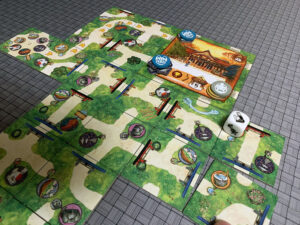 Recently I had told Tony, “I’ve been inspired by One Hundred Torri, and I’ve decided to embrace a Japanese-inspired philosophy when it comes to living my best life.”
Recently I had told Tony, “I’ve been inspired by One Hundred Torri, and I’ve decided to embrace a Japanese-inspired philosophy when it comes to living my best life.”
“Oookaaay…” he responded slowly.
“There’s so much wisdom in that philosophy with aphorisms like ‘Fall down seven times but get up eight’, ‘Be not afraid of going slowly; be afraid of standing still’, and ‘Learn to love the sound of your feet walking away from things that are not meant for you.’ It really resonates with me.”
Tony sighed and replied, “I’m happy for you but you still have to finish the review on that game you’ve been complaining about.”
Meanwhile, follow the sounds of my feet toward something I do like as they walk through the serene gardens in One Hundred Torii’s expansion Diverging Paths. This expansion adds four modules representing different shrines you can incorporate into the base game either one at a time or multiple shrines at a time up to all four included for the most challenging experience. There are also new Gambler and Pilgrim characters that can be used either with the shrines or with the original base game.
Expansion Overview:
For purposes of this review, I’m going to focus on one shrine at a time and will point to Tony’s review for an overview of how the base game plays. The expansion comes with eight new path tiles with four each having a blue and yellow back. Each shrine is placed with one of those two sets with the arrows pointing away from the start tile. At the end of the four tiles place the shrine you’ve selected to use. Each of the shrines has its own setup instructions which, for the sake of brevity, I’ll skip over to focus on how they augment the game.
Fushimi Inari
This is the most straightforward shrine as it just adds another token type which is scored for each tile adjacent to the shrine on a path you just scored. The Fushimi Inari token can be used as a wild for scoring the Landmark achievements.

Kitano
Each player gets four Netsuke discs of the same color and when they score a path that is adjacent to one of the corners of the shrine may make an offering of one or more tokens or coins and then places their disc on top of the offering. It’s possible to make multiple offerings in the same turn if multiple adjacent corners are scored. Another player may replace a Netsuke disc by placing a larger offering when scoring in that corner of the shrine. But the disc and offering tokens are returned to the player who just got outbid. At the end of the game, each player with a disc on a corner of the shrine receives a Large Kitano Shrine token and whoever has the most tokens across all four corners gets an additional Large Kitano Shrine token.
Nonomiya
When scoring a path adjacent to the shrine the player receives a Nonomiya goal card that is to be kept secret from the other players. When a player has met the condition for one or more of their cards that card is revealed and left face up on the table. While a player may score multiple identical cards over the course of the game, they can’t do so on the same turn. Each completed goal card is worth three points at the end of the game.

Shrines at To-Ji Temple
To-Ji Pagoda cards are earned during the Expand the Garden phase by scoring paths adjacent to the shrine. Cards are collected in numerical order. These cards can be used during Thor’s favorite phase, the Get Help phase, but all of the cards collected must be used in any order. Cards one through four provide the benefits of gaining help from one character (Geisha, Poet, Pilgrim, and Gardener cost one token, others are normal costs), gain help from two different characters (again paying the cost), gain any three small tokens, and gain a large landmark token respectively. The fifth and sixth cards are worth five and six points. Only six To-Ji Pagoda cards can be collected by each player.
Lastly, there are two new characters. The Pilgrim character allows you to place a 2×1 lonely path tile during the Get Help phase and then a tile like normal during the Expand the Garden phase. Meanwhile, the Gambler allows players to spend tokens to roll the gambler’s die and place it over a landmark in a manner similar to the Poet.

Game Experience with the Expansion:
One Hundred Torii is an accessible game with relatively low overhead that plays quickly and is full of impactful decisions. This expansion adds more elements that only slightly increase the complexity while adding a lot of variety and depth. Something I appreciate in the design is the consistency that adjacent to tiles always means orthogonal and how smoothly the shrines meld into the base gameplay.
Each shrine’s components go in its own tuck box—which you’ll have to sort when you first open the expansion. After that initial effort, adding one or more shrines to the game is painless.

The Fushiimi Inari shrine feels like a light twist on the base game. Meanwhile, the Kitano Shrine features more player interaction as a very light area control mechanism (it reminds me of claiming runs in Skull Canyon Ski Fest). Conceptually, this is my least favorite due to the negative player interaction but you have to decide if the tokens you’re returning to that player will be worth more than the five points you’re trying to steal from them. And for the player getting out-donated, you at least get your investment back making it far less frustrating than a failed Kickstarter campaign. I really enjoyed this one in solo mode as I was able to keep the AI away from making offerings by strategically using the samurai and geisha.
The Nonomiya Shrine seems complex until you understand the iconography at which point it’s pretty easy to work towards that goal for some easy points. Some goals are significantly more challenging than others which can be frustrating to work towards while your opponent just gains three points effortlessly. A reference card or tile describing what’s in the rule book would’ve been helpful for the first few plays but that’s a minor nitpick.

On the surface, the Shrines at To-Ji seem the most complicated when you start having to activate three and four cards during the get help phase at the start of your turn. And at some point, you must decide if you want the extra resources and landmarks or if you want to hold on for the extra points. This can slow down a game that can already bog down towards the end of the game. I found that by the time I had four cards, I’d look at the remaining tiles and decide that I was too close to 11 points to risk playing them. Meanwhile in solo mode, if you can gain the first card, you basically can wrap up 11 bonus points which sort of removes the expansion from the game unless you use the cards and then let the AI snatch them back up.
Final Thoughts:
If you thought One Hundred Torii needed some more variability or more crunch, then this expansion is absolutely for you. Each shrine adds a mechanic but in a way that feels seamless and that might be the best praise of adding depth without adding undue complexity.
As an alternative to Carcassonne, One Hundred Torii with the Diverging Paths expansion offers multiple, and dare I say, diverging paths to explore. And unlike Carcassonne, adding the shrines generally doesn’t significantly lengthen the game as you’re still playing the same number of tiles each game. I found each shrine satisfying individually but the combination of them offers a lot more opportunities for different gaming experiences.
 Hits:
Hits:
• Four shrines that can be mixed and matched for different experiences.
• Simple to set up each shrine
• New characters to help you get your zen on
• Integrates smoothly into base game
Misses:
• An iconography card for the Nonomiya would’ve been nice
• To-Ji Temple can make some turns long or becomes a non-factor
• Nonomiya Shrine introduces light player conflict (which could be pro for some folks)





















